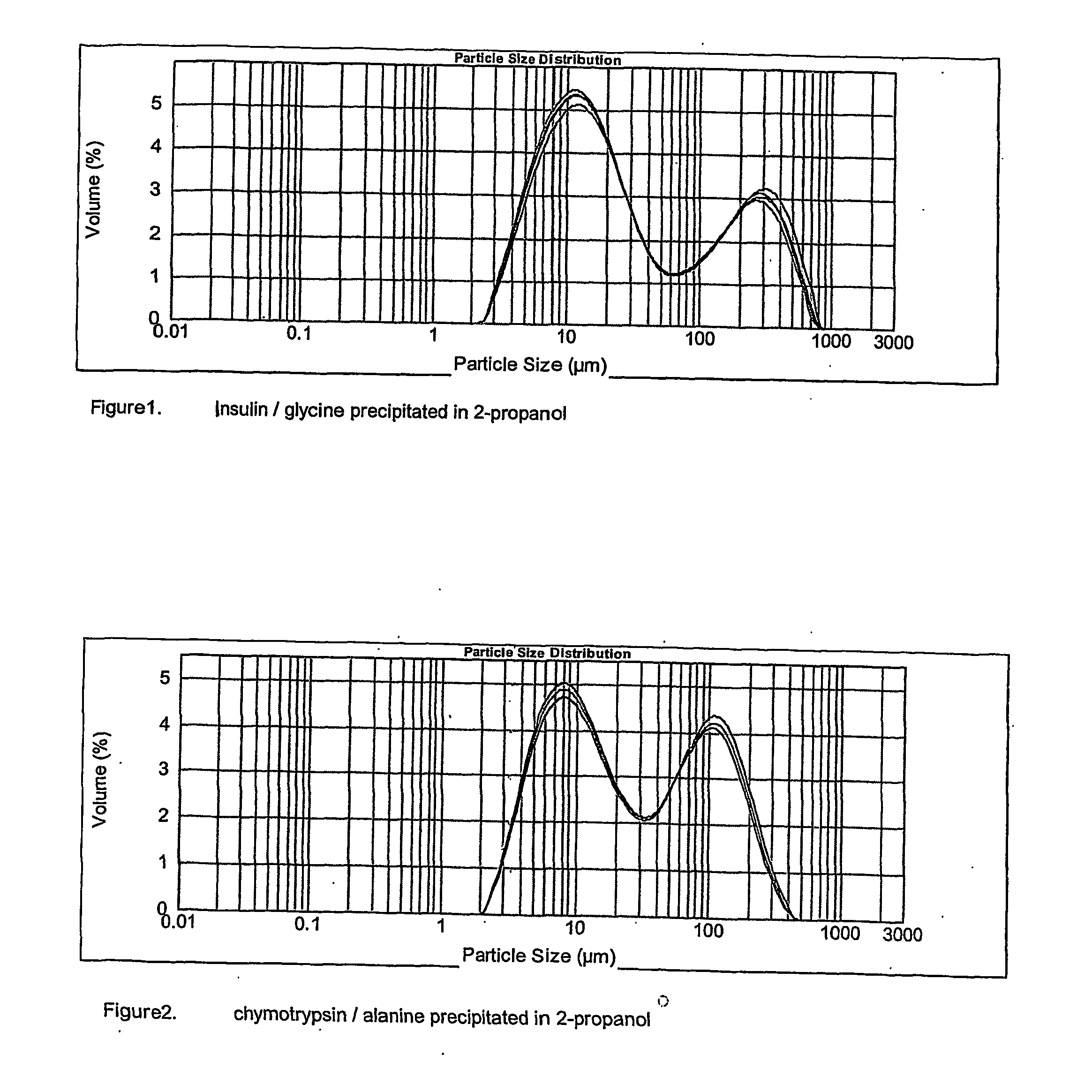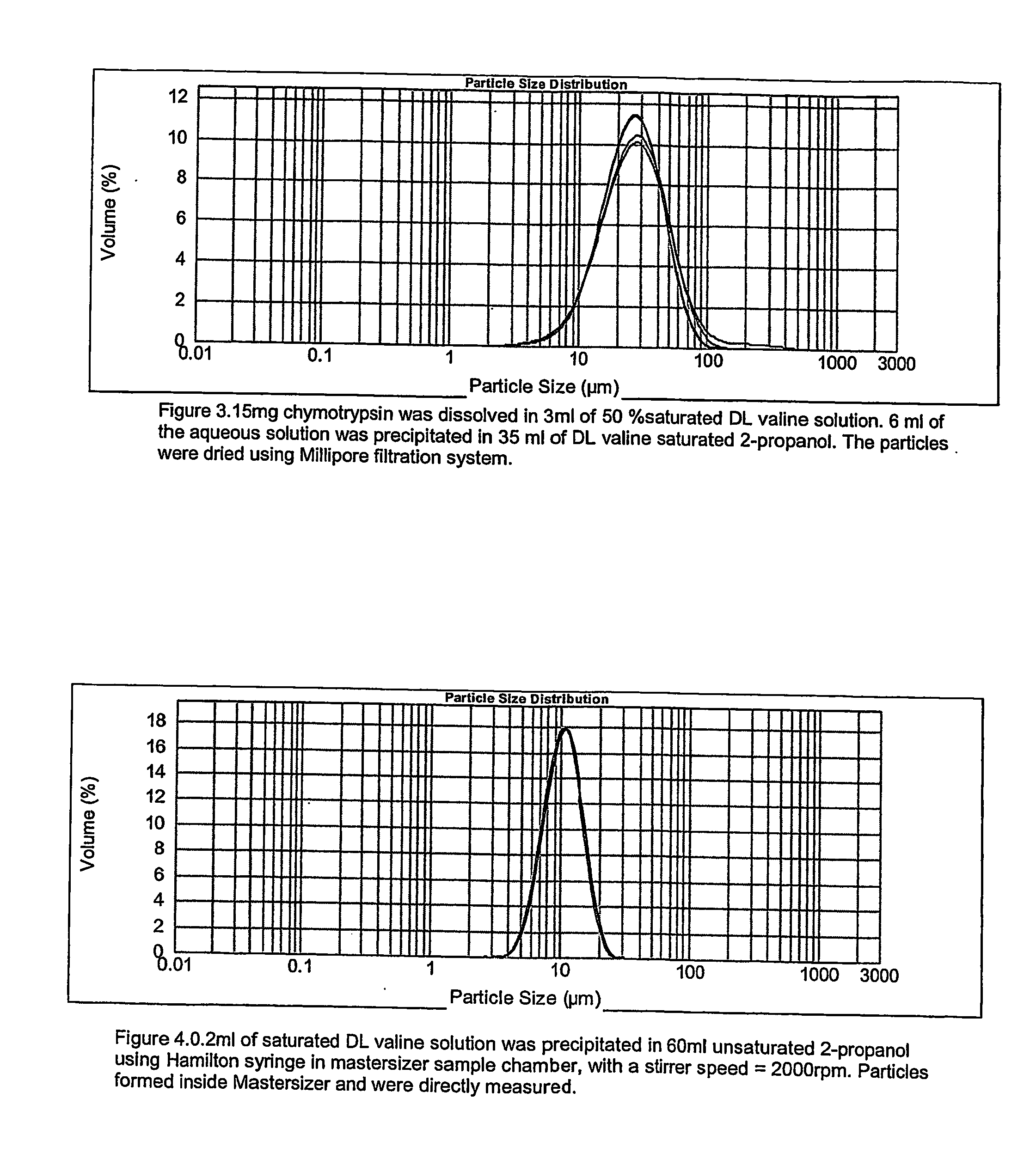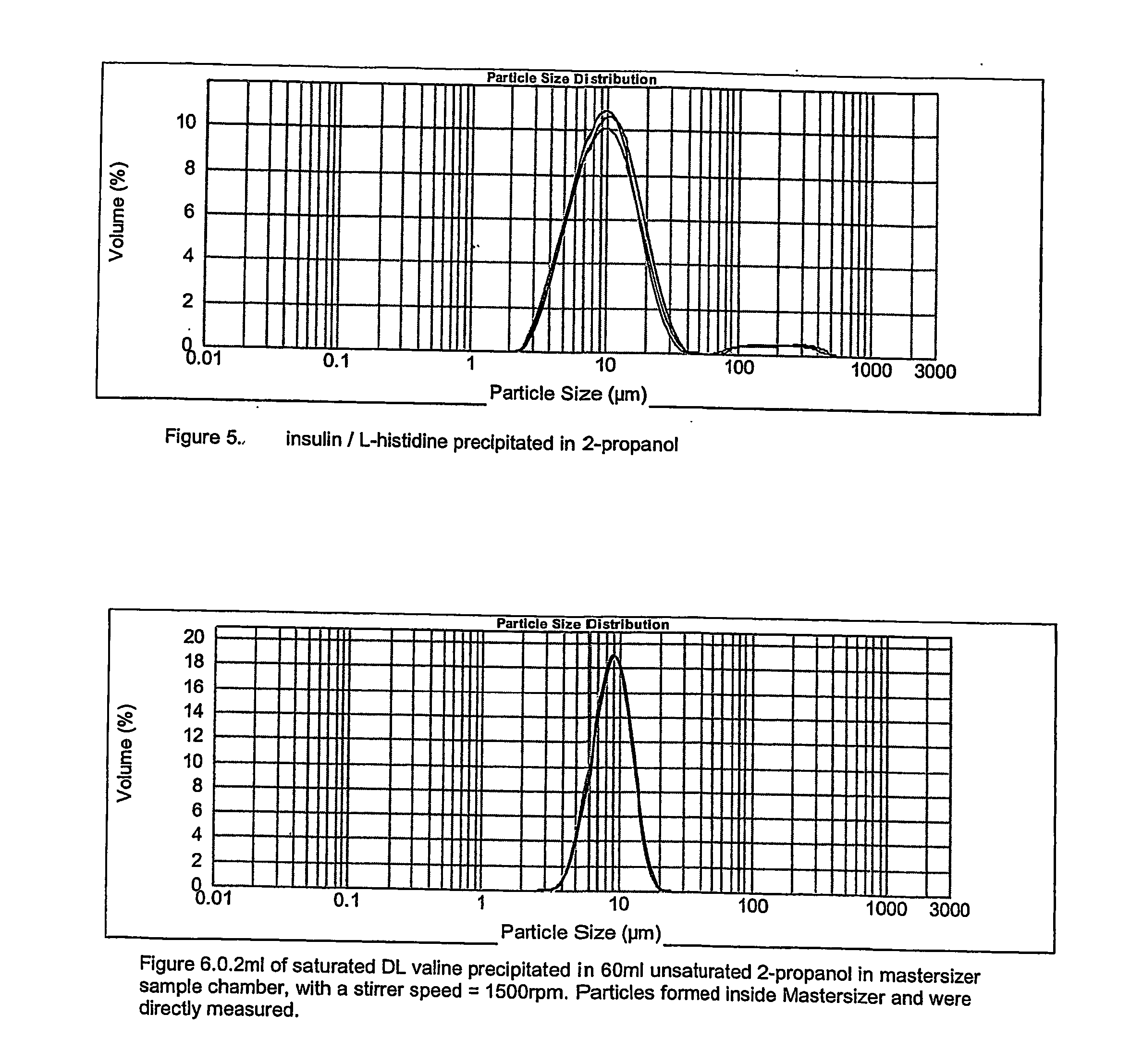Pharmaceutical composition
a technology of pharmaceutical composition and composition, applied in the direction of powder delivery, granular delivery, dna/rna fragmentation, etc., can solve the problems of batch type process suffering from a number of drawbacks, no specific disclosure of pharmaceutical formulations or other bioactive molecules, etc., to achieve cost-effectiveness, prolong shelf life, and improve the effect of production
- Summary
- Abstract
- Description
- Claims
- Application Information
AI Technical Summary
Benefits of technology
Problems solved by technology
Method used
Image
Examples
example 1
[0128] Table 1 shows the conditions used to produce a range of protein coated microcrystals (PCMCs) wherein the bioactive material which forms a coating is insulin and the crystalline core is formed from D,L-valine, L-valine, L-histidine and L-glycine. The microcrystals were made according to the entry under Crystallisation Process in glass vials or flasks and mixing was carried out by magnetic stirring.
[0129] Insulin used is bovine pancreas insulin (Sigma I5500) and USP bovine insulin (Sigma I8405).
[0130] Crystals were isolated by filtering through Durapore membrane filters (0.4 microns) and were then dried in air in a fume hood.
[0131] Protein loadings were determined using Biorad Protein Assay. Percentage of Fine Particle Fraction (FPF) was determined using a multi-stage liquid impinger.
TABLE 1Conc. ofBioactiveBioactive%MoleculeMolecule inproteinBioactivedissolvedSolvent / Solvent% proteinin%Moleculein SolventH2O % (v / v)(mg / ml)Addition of excipientWash StepCrystallisation Proce...
example 2
[0133] Table 2 shows a range of further insulin coated PCMCs made as in Example 1 wherein the crystalline core is formed from L-glycine, L-alanine and L-arginine.
[0134] Insulin used is bovine pancreas insulin (Sigma I5500) and USP bovine insulin (Sigma I8405).
TABLE 2Conc. ofBioactiveBioactiveMoleculeMolecule in% proteinBioactivedissolvedSolvent / Solvent% proteininMoleculein SolventH2O % (v / v)(mg / ml)Addition of excipientWash StepCrystallisation Processrecoveredcrystal% FPF20 mg2 ml ofPropan-2-ol0.442 ml of distilled waterNone3.5 ml of insulin in L-—5.47.2Insulin0.01M HCl9.1% H2Osaturated with L-glycine added dropwise(I5500)and thenglycine added toto 35 ml of propan-2-ol100 μl ofinsulin giving a finalwith constant agitation at1M NaOHpH of 8.66 and a 49%room tempaddedsaturation of L-glycine80 mg8 ml ofPropan-2-ol0.448 ml of distilled waterNone14 ml of insulin in L-—7.010.5Insulin0.01M HCl9.1% H2Osaturated with L-alanine added dropwise(I5500)and thenalanine added toto 140 ml of propan...
example 3
[0136] Table 3 shows a range of insulin PCMCs with a crystalline core of D,L-valine. The water miscible solvent used is propan-2-ol. The microcrystals were made according to the method of Example 1.
Conc. ofBioactiveBioactive% maxMoleculeMolecule in%proteinBioactivedissolved inH2O %SolventWashproteininMoleculeSolvent(v / v)(mg / ml)Addition of excipientStepCrystallisation Processrecoveredcrystal4 mg6.4 ml of9.10.0286.4 ml of distilled waterDry0.7 ml of insulin in D,L-—1.3Insulin0.01M HClsaturated with D,L-valinepropan-valine added dropwise(I5500)and thenadded to insulin giving a2-ol(0.1 ml / min) to 7 ml of320 μl of 1Mfinal pH of 8.8 and a 49%propan-2-ol with constantNaOH addedsaturation of D,L-valineagitation at room temp4 mg3.2 ml of9.10.0553.2 ml of distilled waterDry0.7 ml of insulin in D,L-—2.6Insulin0.01M HClsaturated with D,L-valinepropan-valine added dropwise(I5500)and thenadded to insulin giving a2-ol(0.1 ml / min) to 7 ml of160 μl of 1Mfinal pH of 8.8 and a 49%propan-2-ol with co...
PUM
| Property | Measurement | Unit |
|---|---|---|
| melting point | aaaaa | aaaaa |
| molecular weight | aaaaa | aaaaa |
| solubility | aaaaa | aaaaa |
Abstract
Description
Claims
Application Information
 Login to View More
Login to View More - R&D
- Intellectual Property
- Life Sciences
- Materials
- Tech Scout
- Unparalleled Data Quality
- Higher Quality Content
- 60% Fewer Hallucinations
Browse by: Latest US Patents, China's latest patents, Technical Efficacy Thesaurus, Application Domain, Technology Topic, Popular Technical Reports.
© 2025 PatSnap. All rights reserved.Legal|Privacy policy|Modern Slavery Act Transparency Statement|Sitemap|About US| Contact US: help@patsnap.com



